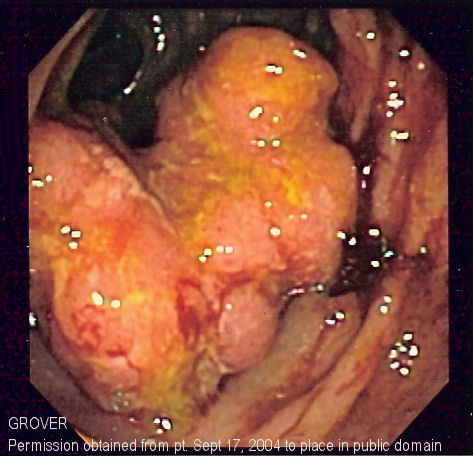Colorectal cancer screening
Editor(s)-in-Chief: C. Michael Gibson, M.S.,M.D. [1] Phone:617-632-7753; Elliot B. Tapper, M.D., Beth Israel Deaconess Medical Center
|
Colorectal cancer Microchapters |
|
Diagnosis |
|---|
|
Treatment |
|
Case Studies |
|
Colorectal cancer screening On the Web |
|
American Roentgen Ray Society Images of Colorectal cancer screening |
|
Risk calculators and risk factors for Colorectal cancer screening |
Overview
Screening procedures
Colorectal cancer can take many years to develop and early detection of colorectal cancer greatly improves the chances of a cure. The U.S. Preventive Services Task Force (USPSTF) recommends screening all patients aged 50-75 for colorectal cancer.[1] The modalities recommended are:
- Fecal occult blood test (FOBT): a test for blood in the stool. Two types of tests can be used for detecting occult blood in stools i.e. guaiac based (chemical test) and immunochemical. The sensitivity of immunochemical testing is superior to that of chemical testing without an unacceptable reduction in specifity. [2]
- Endoscopy:
- Sigmoidoscopy: A lighted probe (sigmoidoscope) is inserted into the rectum and lower colon to check for polyps and other abnormalities.
- Colonoscopy: A lighted probe called a colonoscope is inserted into the rectum and the entire colon to look for polyps and other abnormalities that may be caused by cancer. A colonoscopy has the advantage that if polyps are found during the procedure they can be immediately removed. Tissue can also be taken for biopsy.
The American College of Gastroenterology[3] releases guidelines as well. They add a few additional considerations:
- Screening is recommended in African Americans beginning at age 45 years.
- CT colonography every 5 years is the radiographic screening alternative, when patients decline colonoscopy.
- Fecal immunochemical test for blood (FIT) is preferred over guaiac-based fecal occult blood testing.

other screening techniques
- Double contrast barium enema (DCBE): First, an overnight preparation is taken to cleanse the colon. An enema containing barium sulfate is administered, then air is insufflated into the colon, distending it. The result is a thin layer of barium over the inner lining of the colon which is visible on X-ray films. A cancer or a precancerous polyp can be detected this way. This technique can miss the (less common) flat polyp.
- Virtual colonoscopy replaces X-ray films in the double contrast barium enema (above) with a special computed tomography scan and requires special workstation software in order for the radiologist to interpret. This technique is approaching colonoscopy in sensitivity for polyps. However, any polyps found must still be removed by standard colonoscopy.
- Standard computed axial tomography is an x-ray method that can be used to determine the degree of spread of cancer, but is not sensitive enough to use for screening. Some cancers are found in CAT scans performed for other reasons.
- Blood tests: Measurement of the patient's blood for elevated levels of certain proteins can give an indication of tumor load. In particular, high levels of carcinoembryonic antigen (CEA) in the blood can indicate metastasis of adenocarcinoma. These tests are frequently false positive or false negative, and are not recommended for screening, it can be useful to assess disease recurrence.
- Genetic counseling and genetic testing for families who may have a hereditary form of colon cancer, such as hereditary nonpolyposis colorectal cancer (HNPCC) or familial adenomatous polyposis (FAP).
- Positron emission tomography (PET) is a 3-dimensional scanning technology where a radioactive sugar is injected into the patient, the sugar collects in tissues with high metabolic activity, and an image is formed by measuring the emission of radiation from the sugar. Because cancer cells often have very high metabolic rate, this can be used to differentiate benign and malignant tumors. PET is not used for screening and does not (yet) have a place in routine workup of colorectal cancer cases.
- Whole-Body PET imaging is the most accurate diagnostic test for detection of recurrent colorectal cancer, and is a cost-effective way to differentiate resectable from non-resectable disease. A PET scan is indicated whenever a major management decision depends upon accurate evaluation of tumour presence and extent.
- Stool DNA testing is an emerging technology in screening for colorectal cancer. Pre-malignant adenomas and cancers shed DNA markers from their cells which are not degraded during the digestive process and remain stable in the stool. Capture, followed by Polymerase Chain Reaction amplifies the DNA to detectable levels for assay. Clinical studies have shown a cancer detection sensitivity of 71%-91%.[4]
References
- ↑ Screening for Colorectal Cancer: U.S. Preventive Services Task Force Recommendation Statement.Ann Intern Med. 2008;149:627-637.
- ↑ Weitzel JN: Genetic cancer risk assessment. Putting it all together. Cancer 86:2483,1999. PMID 10630174
- ↑ Rex DK, Johnson DA, Anderson JC, et al. American College of Gastroenterology guidelines for colorectal cancer screening 2009.Am J Gastroenterol. 2009 Mar;104(3):739-50.
- ↑ B. Greenwald (2006). "The DNA Stool Test - An Emerging Technology in Colorectal Cancer Screening".